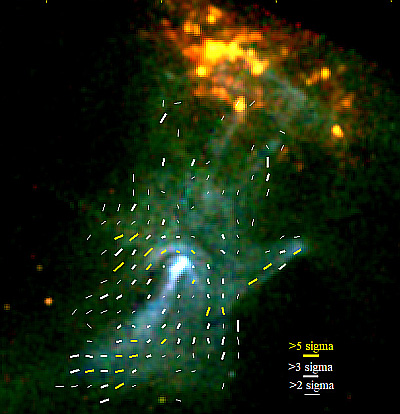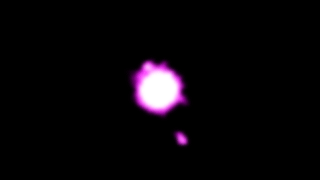Giant galactic magnetic filament disturbed by pulsar
Cool image time! The false-color X-ray picture to the right, reduced and sharpened to post here, was released today by the science team for the Chandra X-ray Observatory, showing some interesting astronomical features about 26,000 light years away near the galactic center.
The press release attempts to catch the ignorant press’s interest by referring to the long white filament that crosses this image as “a bone”, implying that this is similar to a medical X-ray of a person’s bones. Hogwash. What we are looking at is a filament of energized particles forced into this long thin shape by the magnetic field lines that exist in the central regions of the Milky Way galaxy.
What makes this X-ray data of interest is shown in the inset. The pulsar appears to have disturbed that filament, pulling those energetic particles away to form a trailing cloud.
In the first composite image, the largely straight filament stretches from the top to the bottom of the vertical frame. At each end of the grey filament is a hazy grey cloud. The only color in the image is neon blue, found in a few specks which dot the blackness surrounding the structure. The blue represents X-rays seen by NASA’s Chandra X-ray Observatory.
In the annotated close-up, one such speck appears to be interacting with the structure itself. This is a fast-moving, rapidly spinning neutron star, otherwise known as a pulsar. Astronomers believe that this pulsar has struck the filament halfway down its length, distorting the magnetic field and radio signal.
As big and empty as space is, there is still enough stuff within it to cause these kinds of interactions. It just requires the luxury of endless eons, something that we as short-lived humans have trouble conceiving.
Cool image time! The false-color X-ray picture to the right, reduced and sharpened to post here, was released today by the science team for the Chandra X-ray Observatory, showing some interesting astronomical features about 26,000 light years away near the galactic center.
The press release attempts to catch the ignorant press’s interest by referring to the long white filament that crosses this image as “a bone”, implying that this is similar to a medical X-ray of a person’s bones. Hogwash. What we are looking at is a filament of energized particles forced into this long thin shape by the magnetic field lines that exist in the central regions of the Milky Way galaxy.
What makes this X-ray data of interest is shown in the inset. The pulsar appears to have disturbed that filament, pulling those energetic particles away to form a trailing cloud.
In the first composite image, the largely straight filament stretches from the top to the bottom of the vertical frame. At each end of the grey filament is a hazy grey cloud. The only color in the image is neon blue, found in a few specks which dot the blackness surrounding the structure. The blue represents X-rays seen by NASA’s Chandra X-ray Observatory.
In the annotated close-up, one such speck appears to be interacting with the structure itself. This is a fast-moving, rapidly spinning neutron star, otherwise known as a pulsar. Astronomers believe that this pulsar has struck the filament halfway down its length, distorting the magnetic field and radio signal.
As big and empty as space is, there is still enough stuff within it to cause these kinds of interactions. It just requires the luxury of endless eons, something that we as short-lived humans have trouble conceiving.










